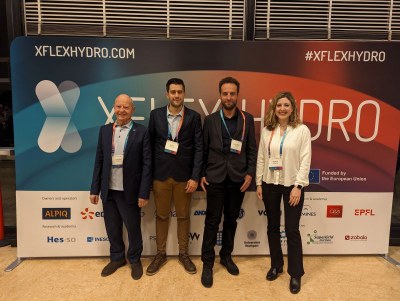News
Site news
Keywords: Francis turbine, Modal behavior, Natural frequencies, Piezo patches, Condition monitoring, Stationary sensors
Our team CDIF-UPC at the #xflexhydro final event! Together, we're driving innovation in hydropower and shaping the #futureofhydro. Excited to connect with experts at the event, sharing experiences and advancing the conversation on the future of hydropower. Proud to share insights from our participation in demonstrators like Frades II, Caniçada, and Vogelgrun, exploring new technologies such as hydraulic short circuit, variable speed and battery hybridization. Let's continue forging ahead as a united team! 🚀 #HydropowerInnovation #RenewableEnergy #TeamWork
During our latest expedition, conducted in collaboration with Elecnor Group, we executed a series of extensive tests aimed at optimizing the operating range of three Kaplan units. Our focus was on enhancing efficiency and stability, crucial factors in the unit's performance. We extend our sincere thanks to all Elecnor staff whose unwavering efforts contributed to the successful conclusion of these tests.
New paper published in the prestigious Journal of Sound and Vibration by the CDIF-UPC PhD Student: Greco Moraga González One of the most crucial parameters for accurately assessing the hashtag#resonances of hashtag#pumpturbines and high head hashtag#Francisturbines is the hashtag#fluiddamping. It can also play a significant role in long-term fatigue damages. The main finding of this paper is that, according to our experiments, fluid damping depends on the vibration amplitude. This dependency is particularly significant for confined structures, as is the case for hydraulic turbines. We propose analytical models that confirm this trend. Publishing in such a journal is highly challenging, given the high technical standards of JSV and the expertise and strictness of the reviewers. However, after three rounds of revisions and fruitful discussions with the reviewers and editor, we believe that the quality of the paper meets the standards of the journal. Thanks to the agreement between Universitat Politècnica de Catalunya and Elsevier, this paper is available as a fully open access paper: https://www.sciencedirect.com/science/article/pii/S0022460X23005485
Project Update: Our collaboration with industrial partner Enel is reaching its conclusion. At the Los Naranjos power plant in Sevilla, we've been diligently investigating solar tracker failures attributed to strong wind gusts. This marks our second project with Enel, and there are more to come. Throughout this initiative, we implemented an online monitoring system, closely analyzing the results over nearly a year. The insights gained have led to the identification of optimal procedures to mitigate wind effects on solar trackers, and we're proposing structural modifications based on our findings. Stay tuned for further developments in our ongoing efforts to enhance the resilience of solar power infrastructure.
During March 2023, CDIF-UPC Universitat Politècnica de Catalunya was in a new Kaplan Turbine in Angola. The turbine experienced strong vibrations problems in the Speed No Load phase. In such conditions it is very difficult to determine the origin of vibrations as the blades and other part of the turbines are totally submerged, confined and rotating. Alexandre Presas and Greco Moraga González used all the accumulated experience of the CDIF-UPC in prototype testing and measurements. Finally, the origin of the vibrations was determined, and the unit could go to the next phase of the commissioning tests. It was a pleasure for us to work in the solution of this problem together with Elecnor Group and TRACTEBEL and to contribute to the electrification of Angola with renewable energy.
Alpiq recently opened its doors to XFLEX HYDRO partners, providing an exclusive look at the latest flexibility upgrade at Z'Mutt pumping station. Z'Mutt, part of the Grande Dixence hydroelectric complex, plays a crucial role in storing and converting potential energy into electricity, supporting the integration of intermittent renewable energy sources.
In the context of XFLEX HYDRO, CDIF-UPC from Universitat Politècnica de Catalunya, together with EDP have published a new paper about a realistic evaluation of the use of variable speed technology in hydropower. Real data of a prototype demonstrator of the XFLEX HYDRO project has been used to evaluate how variable speed would improve the efficiency of a mid-head Francis turbine. It is shown that this technology could be used to generate the same energy as with a conventional fixed speed unit, but using less water.
Exciting learning experience at Iberdrola Campus! Last week of May, Eduard Egusquiza conducted an advanced course on Hydraulic Turbines, Dynamic Behavior, and Vibrations for Iberdrola Engineers. Engaging sessions, talented engineers, and a big thank you to Iberdrola for the opportunity!
Within the frame of the European Project XFLEX Hydro, the benefits of hybridizing a hydroturbine with a battery have been studied. In this investigation, a Kaplan turbine has been hybridized with a battery in paral·lel, which can deliver or substract energy to compensate the frequency deviations of the grid. This is an important novel solution to provide flexibility to the grid with fast response at the same time than minimizing wear and tear of the turbine components. UPC has contributed to this work by installing a monitoring system in the unit and performing the comparisons about wear and tear of the main components involved.









Share: